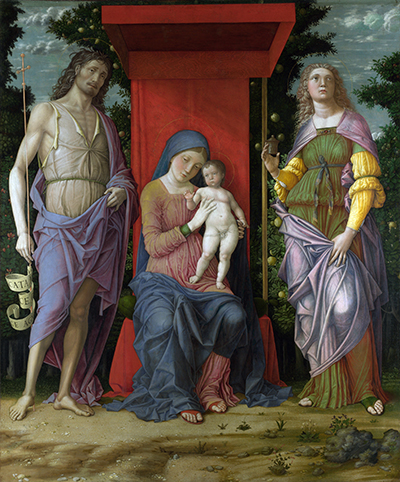The Virgin and Child with Saints (1490-1505) is a late work by Renaissance artist Andrea Mantegna, possibly produced in Mantua.
Originally apprenticed in the historic university city of Padua in the early 1440s, he soon became top painter at the School of Padua. He was eventually invited to become court painter to Mantua's powerful ruling Gonzaga family, the first important artist to be based in this romantic city. By this time, he was son-in-law to Jacopo Bellini, and a true son of the Renaissance.
The painting's complete title is The Virgin and Child with the Magdalen and Saint John the Baptist. The scroll around the cross on John's neck proclaims in Latin Behold the Lamb of God who takes away the sins of the world, part of which can be seen in the painting. The other side has the painter's name with the initials CPF, with the last letter perhaps standing for fecit (or "made this"), and the others possibly short for Comes Palatinus, Mantegna's knighthood of 1469. Produced in egg tempera on canvas as an altarpiece for an unknown church, it would have been a simple task to transport it elsewhere, and indeed, it was first noticed in Milan.
Like others at that time, Mantegna, who lived from 1431 to 1506, was interested in developing new techniques, and in exploring the use of perspective. The Virgin and Child With Saints is a perfect example of how his experience with the concept has allowed the picture to appear more natural. His involvement in the humanist movement led him to study Roman archaeology, and he became one of the first to introduce the classical touches which are apparent in this painting. Himself influenced by Donatello, Uccello and del Castagno, he was now inspiring those who would come after him.
This masterpiece is now in London's National Gallery, and shows Mantegna's confidence in his innovative skills. His lasting influence is noticeable in work by Giovanni Bellini and Vasari, while Leonardo da Vinci learnt from Mantegna's treatment of decorative touches such as fruit, and during two stays to Italy, even Albrecht Dürer was enthusiastic enough to reproduce some engravings. It is perhaps his study and use of space and perspective that is his greatest and most lasting legacy, with his method of ceiling-decoration prevailing for three centuries, and his pupil Correggio going on to build the dome of Parma Cathedral.




